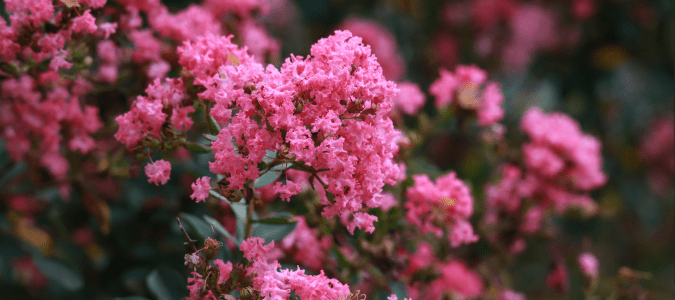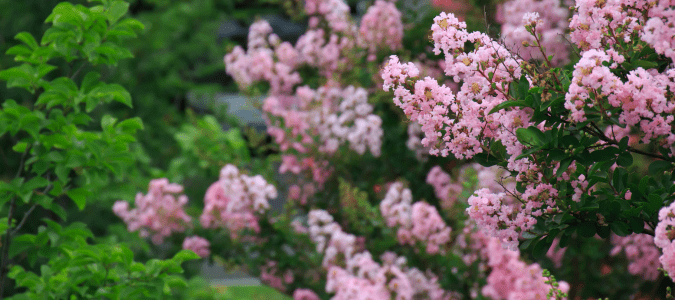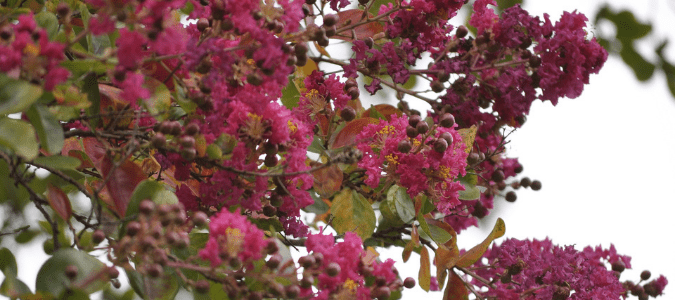
Crape myrtles can be a gorgeous and relatively low-maintenance tree that will spruce up your yard. Not only are they drought tolerant, but they can also survive through humidity and high temperatures. However, homeowners can accidentally ruin these colorful trees if they are not careful. It is important to follow a few helpful maintenance tips to keep your crape myrtles healthy and beautiful.
For one, excessive pruning can ruin a crape myrtle. Only young crape myrtle trees need pruning, and these saplings should be pruned with great care. Cutting back too many or too few branches when the tree is young can make the tree unhealthy, unattractive and difficult to maintain once it gets older.
Before getting started, you’ll need to know what tools you need, the steps involved and what time of year pruning should take place.
Tools for Pruning Your Crape Myrtles
When the time is right, gather the tools you’ll need for the job, including:
- a sturdy ladder;
- a friend or family member to hold the ladder and help with the pruning project;
- goggles, gloves and other protective clothing;
- a prune saw or pole pruner to cut trunks and larger branches and
- hand pruners or loppers for smaller branches.
How to Prune a Crape Myrtle Tree
Once you have prepared your work area, get a sense of which parts of your crape myrtle need pruning. Remember that you can always go back and cut off more if you need to, but you can’t replace branches if you remove too much.
Start by deciding if you need to remove any of the larger parts of the tree. Young crape myrtles often have multiple trunks. If the tree has too many trunks, it can get crowded as it grows. So, it is best to limit the tree to no more than five trunks. Aim to keep the trunks that look the strongest and have enough space between them. This way, they can continue to grow straight and healthy.
For the trunks you would like to remove, it is important to cut them all the way back and as close to the ground as possible. This will not only help the tree look prettier, but it will also reduce the chance that diseases and insects can use the cut surface as an entry point to attack the tree.
Next, prune away suckers from the base of the tree and cut unwanted low branches as close to the trunk as you can. If your crape myrtle is in front of your home, then you might want to cut away all the branches below a certain height. This way, they do not block the view out of your window or make it difficult to walk around the yard. However, if your crape myrtles are close to a fence or you are using them to increase privacy in your yard, then you might decide to leave some branches closer to the ground.
Lastly, take a look at the upper parts of the tree to see if there are any areas that are overcrowded. If the tree looks lopsided or too thick on one side, then you can cut away branches from the thick side to even it out. Also, look for any branches that are rubbing together. Thin out those areas to make sure all the branches have plenty of space to grow. Branches that rub together can weaken and damage each other in the process. This means you might lose both branches if you do not remove one of them early on.
Additionally, cut away branches that are thinner than the thickness of a pencil. Removing weaker branches and thinning out your crape myrtle when it is young will help make sure each branch that remains has the sun and air circulation it needs to stay healthy and continue looking great as it matures.
After you prune your young crape myrtle, it is best to only do minimal pruning as the tree matures. Prune crape myrtles just once or twice a year and only remove parts of the tree that could get in the way of the tree’s healthy growth. This includes removing suckers coming out of the base of the tree, thin branches and limbs that have started growing into or crossing each other. Avoid cutting off the top layer of your crape myrtle and tree crowning. If you want a shorter tree, it is best to buy a shorter variety of crape myrtle instead of trying to tame taller varieties.
While there are many benefits to pruning, you do have to be careful. If you prune an older crape myrtle too often or too much, then you might end up with ugly stumps instead of beautiful flowering trees. You will weaken your tree, which means the crape myrtle could start to develop small, weak branches that are not strong enough to hold flowers. Additionally, the tree might produce fewer and fewer flowers each year, and its bark might not ever mature into the colorful bark that crape myrtles are famous for.
While crape myrtles are hardy trees, it can be tricky to maintain them if you do not know what to look for. That is why it is best to contact a certified arborist to help care for your trees. These professionals have the expert knowledge, experience and specialized tools needed. They can prune your crape myrtles and keep them healthy year after year. A reputable tree specialist can take care of everything needed to keep your crape myrtles and the rest of your yard looking beautiful, so you don’t have to worry about it.
When to Prune Crape Myrtles
Depending on the climate of your area, pruning should take place in late winter or early spring. It should definitely happen before the first blooms start to grow. It is important not to go overboard when cutting back the tree’s pretty branches. Many people cut their crape myrtles down to a nub, which is an eyesore in more than one way.
Not only does it look like a horrible accident, but such a severe prune stops the interesting, mottled bark from forming. Why buy and plant such pleasant trees only to remove all that beauty? Some people say that such a huge amount of cutting back on the trees promotes new branches to form, but what it really does is make for weak branches that break easily. It takes away everything that makes crape myrtles so popular in the first place.
Don’t Prune Just to Prune
You shouldn’t prune the crape myrtles just to prune them. There are very specific reasons that your crape myrtles would need landscaping work. These are: to reduce the risk of the branches interfering with wires or your home; to help maintain the tree’s health and beautiful structure, or to improve them; or for another specific need you might have. The “topping,” or cutting them down drastically, doesn’t hit any of those needs and hurts the trees. If you aren’t sure whether your crape myrtles need pruning or other work, it’s best to consult a professional.
If you want to tackle the pruning yourself, you are going to want to use the proper tools and do the job right. And remember that new growth, which is where the new blooms form, occurs about four to five inches below wherever you cut the branches. Another reason to be careful in your care of the trees.
Crape Myrtle Bush Versus Tree
Many people wonder what the difference is between the types of crape myrtles. Is it a crape myrtle bush or a tree? Short answer is a crape myrtle tree is taller than a crape myrtle bush.
The bushes grow anywhere between two feet for the dwarf type and other varieties are from five to 15 feet high and all have multiple stems. Crape myrtle trees can be as tall as 20 feet taller than bushes, with some of the trees getting all the way to 35 feet high!
The shape of the plant is also a clue as to whether it is a tree or a bush. Most flowering crape myrtle shrubs are generally wider than tall, with a broad crown between 5 to 15 feet wide. These shrubs can have beautiful red, white, pink or purple flowers that bloom in the summer and attract birds and pollinators. They grow well in warm climates and work great as borders and container plants as well.
When grown in sunny, warm climates, crape myrtle bushes will flower every year. The bushes grow very quickly, with blooms from spring to early fall. Some varieties will even hold on to their flowers until the first frost of the year.
If adding some of these plants to your landscape sounds right up your alley, but you aren’t sure you have the time or energy to install the shrubs, call in a professional. Landscaping experts know what will grow the best in your particular area, and what will look great, too.
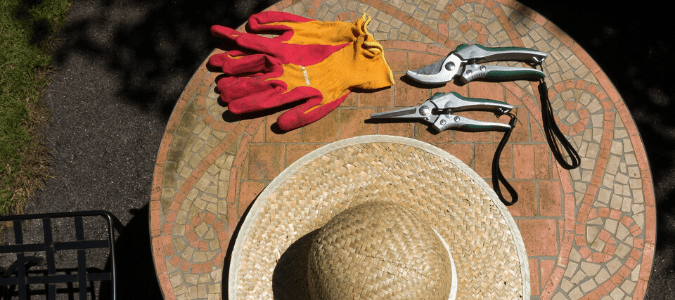
Crape Myrtle Care Tips
When you first plant crape myrtles, select a sunny part of your yard because these trees prefer full sun. How far apart you should plant each crape myrtle will depend on what variety you have. Dwarf forms of these trees like the Chickasaw only grow to about three feet tall. On the other hand, larger varieties like Natchez crape myrtles can get to 20 feet or taller. It is important to plant larger trees about six to eight feet apart from each other, so their roots have enough room to grow. Smaller crape myrtles only need about two to three feet between each tree.
Right after you plant them, mulch around the base of the tree and water them once or twice each week to help them get established. Once crape myrtles mature, they usually do not need much watering or fertilization. However, you can fertilize the trees once a year in the spring and water them as needed during extremely dry seasons.
Other things you can do to care for mature crape myrtle trees are mulching and periodic pruning. Putting mulch around the trees should help their roots stay at the right temperature and moisture level. Additionally, you can prune the trees in late winter. Remember to only remove growths that could affect the health of the tree. For example, weak branches, suckers and any branches that are too close to the home.
Instead of trying to tackle this project on your own, you can contact an experienced professional for all your tree care needs. They can not only help with your immediate needs, but they can also work with you to set up regular visits that cover a range of services for your trees and the rest of your property. They can help you understand your service options, answer your questions and give you the information you need to choose the best plan for your specific tree and lawn care needs.
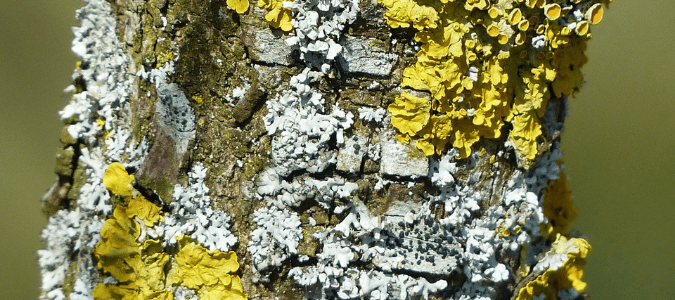
Crape Myrtle Diseases
Crape myrtles are typically a great choice for any yard because they usually need little care to keep them healthy and beautiful year after year. However, over-pruning these trees or allowing them to get too thick can leave them vulnerable to disease.
One of the most common crape myrtle diseases is powdery mildew. This most often happens when trees do not get enough sun or when they get too dense. This fungus looks like patches of white or gray powder on the leaves and flowers. To avoid this disease, plant trees in sunny areas and thin them out each year by pruning away sprouts from the bottom of the tree and weak branches.
Some other kinds of diseases are actually symptoms of other problems. For example, lichens typically start to grow on a crape myrtle if the tree is not healthy. Lichens, which you can see in the image above, are green or grayish crusts that can grow on branches and trunks of crape myrtles. Another kind of disease that can attack crape myrtles is sooty mold. This mold looks like black soot on leaves and stems, and it typically only shows up if the tree has harmful insects like aphids or mealybugs.
If you think your crape myrtle might be sick, contact a tree specialist. A tree specialist can figure out the best ways to save your diseased tree. Additionally, these professionals can often take on other tasks such as tree air excavation and tree trimming.
ABC Can Keep Your Crape Myrtles Healthy
There can be a lot involved with taking care of trees. For healthy, happy trees, contact ABC Home & Commercial Services. Our certified arborists will ensure that your trees grow strong and beautiful.
